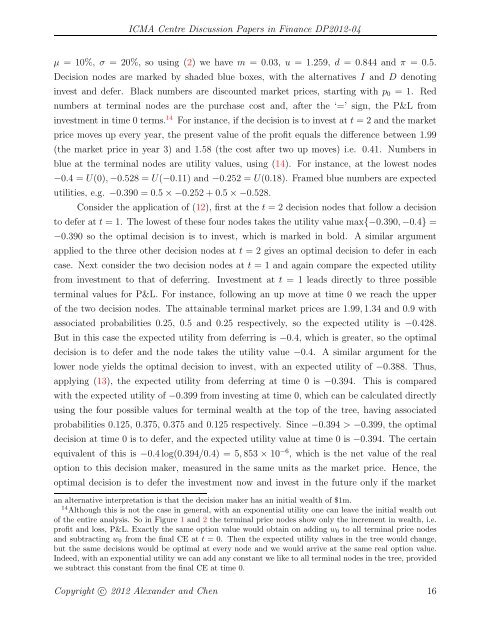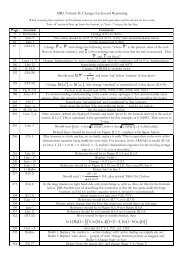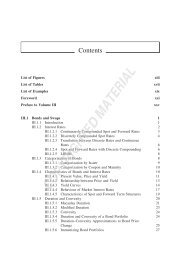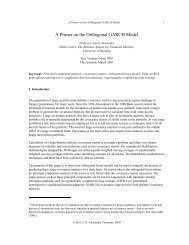A General Approach to Real Option Valuation with ... - ICMA Centre
A General Approach to Real Option Valuation with ... - ICMA Centre
A General Approach to Real Option Valuation with ... - ICMA Centre
You also want an ePaper? Increase the reach of your titles
YUMPU automatically turns print PDFs into web optimized ePapers that Google loves.
<strong>ICMA</strong> <strong>Centre</strong> Discussion Papers in Finance DP2012-04μ = 10%, σ = 20%, so using (2) wehavem =0.03, u =1.259, d =0.844 and π =0.5.Decision nodes are marked by shaded blue boxes, <strong>with</strong> the alternatives I and D denotinginvest and defer. Black numbers are discounted market prices, starting <strong>with</strong> p 0 =1. Rednumbers at terminal nodes are the purchase cost and, after the ‘=’ sign, the P&L frominvestment in time 0 terms. 14 For instance, if the decision is <strong>to</strong> invest at t =2andthemarketprice moves up every year, the present value of the profit equals the difference between 1.99(the market price in year 3) and 1.58 (the cost after two up moves) i.e. 0.41. Numbers inblue at the terminal nodes are utility values, using (14). For instance, at the lowest nodes−0.4 =U(0), −0.528 = U(−0.11) and −0.252 = U(0.18). Framed blue numbers are expectedutilities, e.g. −0.390 = 0.5 ×−0.252 + 0.5 ×−0.528.Consider the application of (12), first at the t = 2 decision nodes that follow a decision<strong>to</strong> defer at t = 1. The lowest of these four nodes takes the utility value max{−0.390, −0.4} =−0.390 so the optimal decision is <strong>to</strong> invest, which is marked in bold. A similar argumentapplied <strong>to</strong> the three other decision nodes at t = 2 gives an optimal decision <strong>to</strong> defer in eachcase. Next consider the two decision nodes at t = 1 and again compare the expected utilityfrom investment <strong>to</strong> that of deferring. Investment at t = 1 leads directly <strong>to</strong> three possibleterminal values for P&L. For instance, following an up move at time 0 we reach the upperof the two decision nodes. The attainable terminal market prices are 1.99, 1.34 and 0.9 <strong>with</strong>associated probabilities 0.25, 0.5 and 0.25 respectively, so the expected utility is −0.428.But in this case the expected utility from deferring is −0.4, which is greater, so the optimaldecision is <strong>to</strong> defer and the node takes the utility value −0.4. A similar argument for thelower node yields the optimal decision <strong>to</strong> invest, <strong>with</strong> an expected utility of −0.388. Thus,applying (13), the expected utility from deferring at time 0 is −0.394. This is compared<strong>with</strong> the expected utility of −0.399 from investing at time 0, which can be calculated directlyusing the four possible values for terminal wealth at the <strong>to</strong>p of the tree, having associatedprobabilities 0.125, 0.375, 0.375 and 0.125 respectively. Since −0.394 > −0.399, the optimaldecision at time 0 is <strong>to</strong> defer, and the expected utility value at time 0 is −0.394. The certainequivalent of this is −0.4log(0.394/0.4) = 5, 853 × 10 −6 , which is the net value of the realoption <strong>to</strong> this decision maker, measured in the same units as the market price. Hence, theoptimal decision is <strong>to</strong> defer the investment now and invest in the future only if the marketan alternative interpretation is that the decision maker has an initial wealth of $1m.14 Although this is not the case in general, <strong>with</strong> an exponential utility one can leave the initial wealth ou<strong>to</strong>f the entire analysis. So in Figure 1 and 2 the terminal price nodes show only the increment in wealth, i.e.profit and loss, P&L. Exactly the same option value would obtain on adding w 0 <strong>to</strong> all terminal price nodesand subtracting w 0 from the final CE at t = 0. Then the expected utility values in the tree would change,but the same decisions would be optimal at every node and we would arrive at the same real option value.Indeed, <strong>with</strong> an exponential utility we can add any constant we like <strong>to</strong> all terminal nodes in the tree, providedwe subtract this constant from the final CE at time 0.Copyright c○ 2012 Alexander and Chen 16











